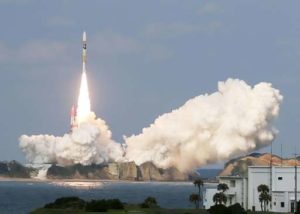
In Part Three of this SpaceWatch Middle East multi-week theme on China’s Space Silk Road and the Middle East, Professor Kazuto Suzuki of Hokkaido University, Japan, argues that Japan’s recent space policies have been developed in response to China’s Space Silk Road, and that Japan has been very proactive in the Middle East as a commercial provider of space systems and space services as a result.
For many years, Chinese foreign assistance (or rather, investments) to developing countries were considered a challenge to the Japanese strategy of peaceful expansion of its influence through economic means. Since Japan has self-restricted its military capability, economic assistance was almost the only channel to increase its presence in the international sphere and be recognised by its partners. Japan crippled its wings of hard power so that it can only use its soft power.
China, on the other hand, has been developing its military capability to counter the pressure from outside actors, particularly the United States. Although it may seem that China has increased its military spending to provide a challenge to U.S. global hegemony, from the Japanese point of view, China has less global but more regional ambitions. Its primary objective is to establish exclusive power in the areas surrounding its territory and to establish buffer zones beyond its line of defence. Thus, the first island line (South of Japan-Okinawa Islands-Philippines-South China Sea) and the second island line (Izu Islands-Guam-Papua New Guinea) are designated as the lines of defence outside its territorial waters. Beyond these lines, China has less aggressive ambitions to control through military force, instead using economic measures. One Belt One Road (or New Silk Road) is a grand strategy for improving Chinese presence in the world, especially in Asia and the Middle East.
This One Belt One Road strategy conflicts directly with the Japanese strategy for maintaining and building influence in the global arena. In particular, the Asian Infrastructure Investment Bank (AIIB) is of great concern because it is encroaching into the area where the Asian Development Bank (ADB) has traditionally served in the role for international development. From its establishment, Japan has been the largest contributor to ADB, and a Japanese official has been appointed as its president. For many in Japan, AIIB seems to challenge the role that ADB has played in assisting development in Asian countries, as well as challenging Japan’s leadership in it.
Does this same challenge happen in the domain of space? Not quite. For many years and for a variety of reasons, Japan has been hesitant to export its spacecraft to foreign countries. First, Japanese space programmes focused on the development of technological capabilities, so reducing cost and improving reliability were not the primary goals. Japanese industry was not keen on improving international competitiveness. Second, Japan had limited itself to exporting military-related items. The three principles of arms export prohibits Japanese industry from exporting to any customer with military affiliation; thus making it very difficult for the industry to find foreign customers. Third, the Japanese government did not enthusiastically encourage the industry to export. The Ministry of Education, Science and Technology (MEXT) was responsible for the research and development (R&D) policy but not to build industrial policy. The Ministry of Economy, Trade, and Industry (METI) has a division responsible for space industry, but it has been a very small office with little influence in overall policy making. For these reasons, Japan has not established itself as the major exporter of space technology, so China does not need to challenge Japanese leadership in space.
However, the situation is changing because of the emergence of China as a global player in space. The Japanese Basic Space Law was established in 2008 partly because of the Chinese sale of satellites to Nigeria, Venezuela, and Indonesia. Japanese lawmakers believed that such international contracts aimed to gain access to the natural resources of each of these countries, and they thought Japan should pursue a similar strategy. Thus, Article 6 of the Basic Space Law specifically spells out that “space development has to contribute to the national interest in international society by promoting diplomatic activities on space.” This was a direct response to Chinese activities in developing countries, so that it is Japan who has to challenge the Chinese share in resource rich countries.
Thus, in the après Basic Space Law, Japan aimed mainly on those countries that have demands for developing their space capabilities and resources to which Japan would like to have access. The main fields of play are the Middle East and East Asia. Japanese industry is working aggressively on the countries in these regions and earned contracts with Singapore, Taiwan, Turkey, and Qatar for communications satellites, and South Korea and the UAE for satellite launches. Furthermore, the Japanese government established the “Task Force for Exporting Space Systems Overseas” in 2015 to accelerate such international sales.
While such an intensive international action is driven by the demand from the industry to improve its international competitiveness, Chinese industry — most of it still state-owned — is not as enthusiastic as Japanese industry. Their interest in the international market is more or less driven by their strategic needs rather than by a desire for commercial success. Therefore, a Japanese effort to foster these markets is gaining momentum, whereas the Chinese presence is getting smaller. However, the new Chinese strategy, One Belt One Road, may revitalize its interest in expanding China’s role in this region, and AIIB would help finance the export of spacecraft from China. The Japanese government is clearly aware of the potential that One Belt One Road needs to be supported by space infrastructure, and China will be pushing hard for its industry to penetrate in these countries’ markets. In this context, the Japanese government has published a new space industrial policy document called “Space Industry Vision 2030,” which aims to improve the international competitiveness of Japanese industry and encourage the export of space products to international markets.
The strategic and industrial rivalry between Japan and China has just began.

Kazuto Suzuki is Professor of International Politics at the Graduate School of Law of Hokkaido University, Japan. He graduated from the Department of International Relations, Ritsumeikan University, and received his Ph.D. from Sussex European Institute, University of Sussex, England. He has been working on issues related to science and technology, industrial policy and regulations of European Union. He has worked in the University of Tsukuba from 2000 to 2008, and moved to Hokkaido University. He has conducted research from International Political Economy perspective in Space Policy, together with nuclear energy policy (contributed to Independent Investigation Commission of Fukushima nuclear accident), export control policy, science and technology policy, counter-terrorism, and policies on market regulation. A prolific author, his most recent publications include, Regulatory Power of European Union (2012, Japanese) and Space and International Politics (2011, Japanese), and Policy Logics and Institutions of European Space Collaboration (2003).
Original published at: https://spacewatch.global/2017/08/swmethemes-chinas-space-silk-road-middle-east-japanese-perspective/
 SpaceWatch.Global An independent perspective on space
SpaceWatch.Global An independent perspective on space

